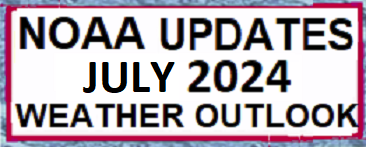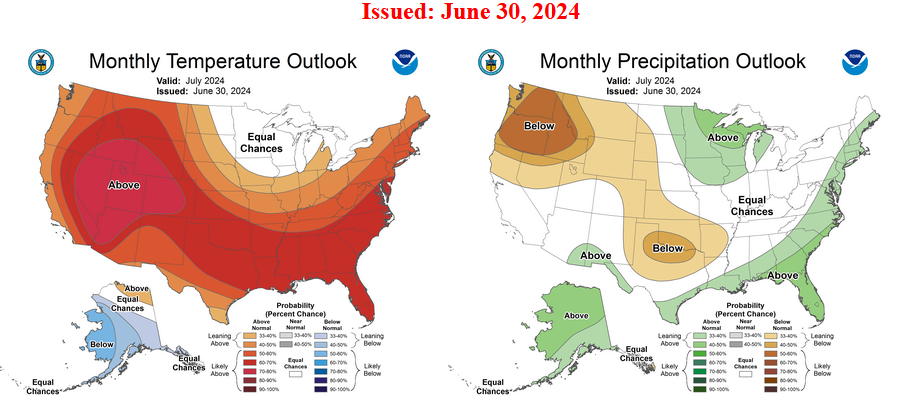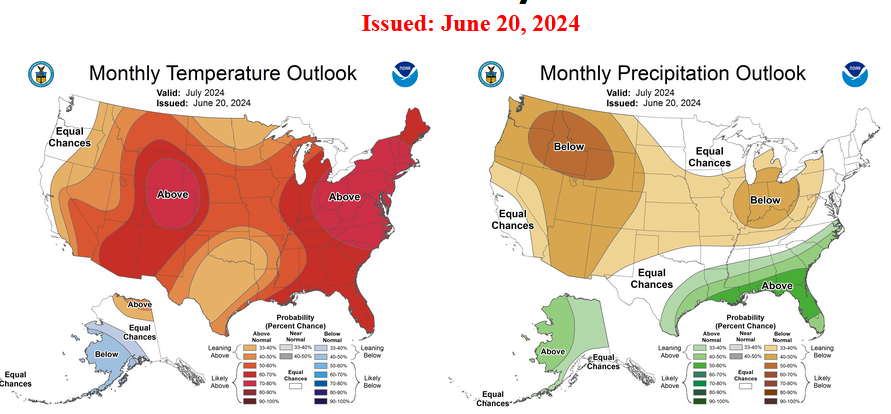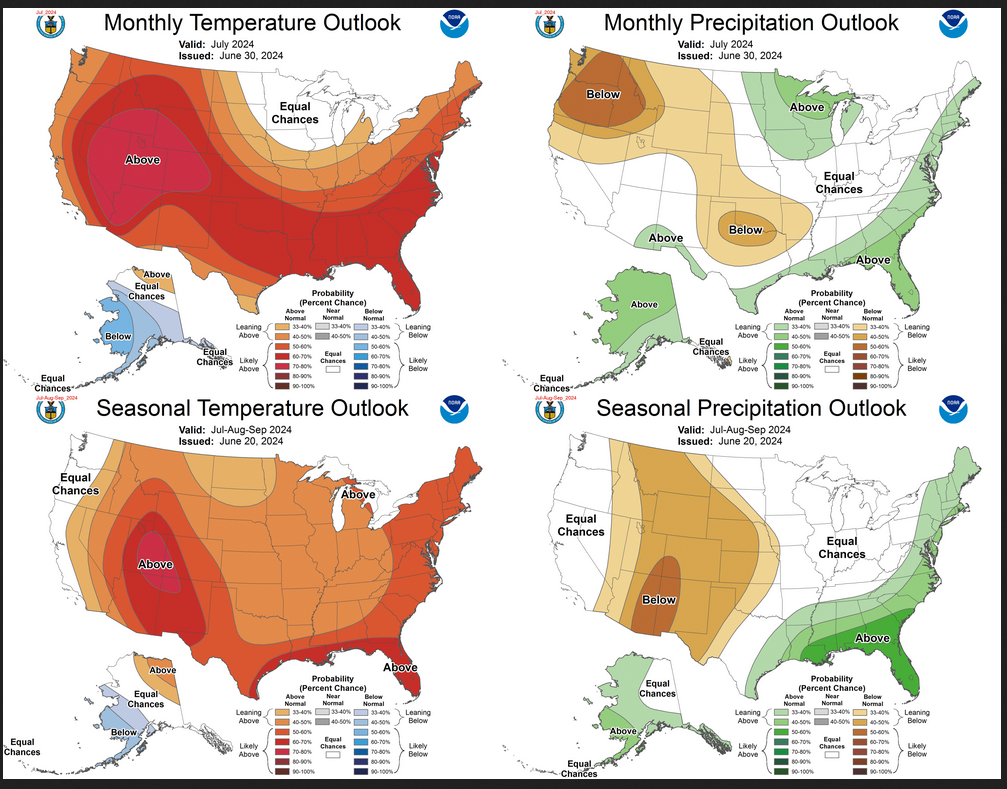Today Through the Fourth Friday (22 to 28 days) Weather Outlook for the U.S. and a Six-Day Forecast for the World: posted July 4, 2024
This article focuses on what we are paying attention to in the next 48 to 72 hours. The article also includes weather maps for longer-term U.S. outlooks and a six-day World weather outlook which can be very useful for travelers.
First the NWS Short Range Forecast. The afternoon NWS text update can be found here after about 4 p.m. New York time but it is unlikely to have changed very much from the morning update. The images in this article automatically update.
Short Range Forecast Discussion
NWS Weather Prediction Center College Park MD
Thu Jul 04 2024
Valid 12Z Thu Jul 04 2024 – 12Z Sat Jul 06 2024…Extremely dangerous and record-breaking heatwave to impact much of the
West through this weekend……One more day of oppressive heat and humidity across the Southern Plains
and Lower Mississippi Valley today before steamy temperatures focus over
the Mid-Atlantic and Southeast……Flash flooding and severe thunderstorms possible throughout parts of
the Midwest, Ohio Valley, and Southern Plains this Independence Day…A significant and extremely dangerous heatwave is set to build throughout
the West to end this week and into the extended holiday weekend, with
several days of record-breaking heat forecast. An upper-level high
situated just off the West Coast today is forecast to strengthen and
reorient directly over the western U.S. by Friday. This pattern will
support well above average temperatures over California and into southwest
Oregon today before heat spreads further throughout the western U.S. this
weekend. High temperatures are forecast to reach into the 105-115F range
for interior California away from the immediate coastline, as well as
across much of the Desert Southwest. Locally higher temperatures into the
120s are possible in the typical hot spots of the Desert Southwest.
Searing afternoon temperatures will also spread into the Northwest and
parts of the central Great Basin, with widespread highs rising into the
90s and low 100s. Dozens of daily record high temperatures are possible,
expressing the rarity of this early-July heatwave. The duration of this
heat is also concerning as scorching above average temperatures are
forecast to linger into next week. Heat impacts can compound over time,
therefore it is important to remain weather aware and follow the advice of
local officials. This level of heat throughout parts of the Mojave Desert
and Sacramento/San Joaquin valleys of California could pose a risk to
anyone if proper heat safety is not followed. It is imperative to stay
hydrated, out of direct sunlight, and in buildings with sufficient
air-conditioning when possible. It is also equally as important to check
on the safety of vulnerable friends, family, and neighbors.Oppressive heat and humidity will also be found throughout the southern
Plains and lower Mississippi Valley today, while expanding eastward to the
Mid-Atlantic and Southeast for the end of the week. High temperatures
rising into the upper 90s and low 100s are expected, with heat indices
soaring into the 110s across the lower Mississippi Valley. Warm overnight
conditions in the upper 70s and low 80s will offer little relief, leading
to a dangerous situation for those without access to adequate cooling. A
cold front entering the southern Plains is anticipated to offer cooler and
below average temperatures to Oklahoma, much of northern/western Texas,
and the Mid-South by Friday. Above average temperatures are then
anticipated to confine to the Southeast and Mid-Atlantic for the start of
the weekend, with afternoon highs into the mid-to-upper 90s. If planning
to spend an extended amount of time outdoors this Fourth of July, be sure
to use caution and act quickly if you see signs of heat-related illnesses.An active and stormy weather pattern over the central U.S. is expected to
create chances for severe thunderstorms and heavy rainfall, which could
impact holiday gatherings through early this weekend. A developing area of
low pressure over the northern Plains is forecast to progress into the
upper Midwest by tonight and team up with a lingering frontal boundary
stretching from the lower Great Lakes to the southern Plains to trigger
some meteorological fireworks. Thunderstorm chances span from the southern
Plains/Rockies to the middle/upper Mississippi Valley and also eastward to
the Ohio Valley and Mid-Atlantic. However, the greatest threat for strong
to severe thunderstorms will be near/along the frontal boundary through
parts of the middle/upper Mississippi Valley and southern Plains. Damaging
wind gusts and frequent lightning are the most likely weather hazard
associated with these Fourth of July storms. Flash flooding will remain a
concern throughout the upper Midwest as well due to yet another round of
thunderstorms overlapping areas dealing with ongoing river flooding and
saturated soils, with scattered flash flooding also possible between the
Ohio Valley and southern Plains. On Friday, thunderstorms will continue to
progress eastward with the frontal boundary into much of the eastern third
of the country. Isolated strong to severe storms and flash flooding are
possible. The greatest threat for damaging wind gusts associated with
these storms will be across the upper Ohio Valley. Elsewhere, daily
thunderstorm chances associated with daytime heating are possible along
the Gulf Coast and Florida. Scattered showers and thunderstorms are also
possible throughout the north-central U.S. this weekend as upper troughing
remains over the region. Residents and visitors located within areas
expecting severe weather and/or heavy rainfall are advised to remain
weather aware, have multiple ways to receive warnings, and never drive
across flooded roadways.Have a safe Independence Day!







